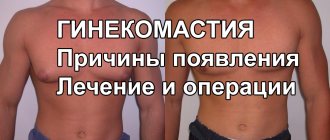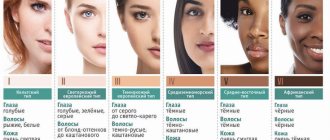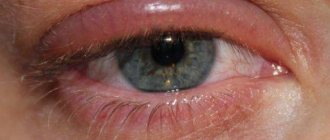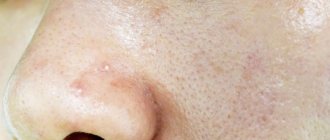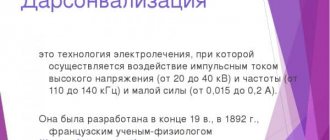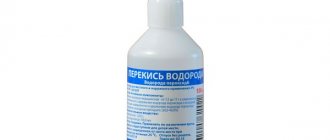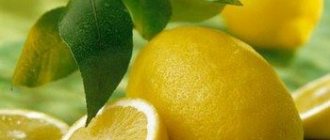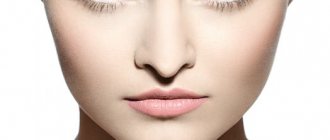From this article you will learn:
- why do acne appear on the chin, forehead or cheeks,
- reasons for their development in women,
- the most effective remedies for acne on the face,
- use of phototherapy (IPL) and laser.
The article was written by a specialist with higher medical education.
Pimples on the face are inflammatory formations on the skin, which are a consequence of the formation of acne (open and closed comedones) in the hair follicles and their subsequent infection. There are 2 types of acne - the so-called “papules” and “pustules”. Papules look like inflamed bumps on the skin, but they do not contain pus inside. Pustules are classic pimples in which a blister of pus has already formed.
Papules can be independent formations and, persisting for up to 2 months, can then disappear without a trace. However, most often papules turn into pustules. In general, the term “acne” is a colloquial expression, and it is correct to call this disease papulopustular acne. This form is usually preceded by the comedonal form of acne, which is nothing more than acne. The formation of blackheads (sebaceous plugs) in the hair follicles is a necessary basis for the subsequent formation of acne.
Types of acne on the face in teenagers (papules) -
Pimples in the form of pustules -
Pustules and papules are superficial inflammatory elements. Pustules go through their full development cycle in an average of 10-12 days, and after they disappear, a bright hyperpigmented spot remains in their place. As we said above, papules can persist from 10 days to 2 months, and they can either turn into pustules or disappear without a trace (or rather, weakly pigmented spots remain in their place). You probably already realized that it is useless to squeeze out papules, and this can only lead to increased inflammation and suppuration.
Getting rid of acne on your face if you have mild acne (moderate amount of superficial inflammatory elements) is not very difficult. However, in a number of patients, deep inflammatory elements can also form - these include the so-called indurative, abscessing, phlegmonous, draining, and conglobate acne. After the disappearance of such inflammatory elements, superficial or deep atrophic scars remain in their place, less often keloid scars.
The most common location of acne is if we talk about the face, then most often acne appears on the forehead, as well as acne on the chin. No less common localization are pimples on the cheeks or in the area of the ears. Some patients may experience acne on the scalp (in the scalp), as well as in the back and shoulders. This localization is due to the fact that it is in these areas that the skin contains the maximum number of sebaceous glands - about 400 to 800 per 1 cm2.
Acne on the face in teenagers: causes
We have already said above that it all starts with the comedonal form of acne, i.e. since the appearance of acne. The main reason for the formation of acne in adolescence is an increase in the production of androgens during puberty (puberty). The main androgen in girls is androstenedione, and in boys it is testosterone. Puberty for girls begins at approximately 12-13 years of age, for boys at 14-15 years of age. It is during this period that approximately 85% of adolescents experience the first manifestations of the comedonal form of acne (acne).
Let us remember that the main elements of acne are comedones (white or blackheads), which are non-inflammatory formations. In the middle and late teenage period, against the background of comedones, inflammatory elements (papules and pustules) already begin to predominate, which will indicate the transformation of the comedonal form of acne into the papulopustular form. The course of mild forms of acne usually lasts no more than 4-5 years, but the course of moderate-severe forms can last even 10-12 or more years.
The most striking clinical picture of acne (blackheads and pimples) is observed in girls between the ages of 17 and 18, and in boys between the ages of 19 and 21. It should be noted that girls are less fortunate and are characterized by a longer course of acne, which is also due to the presence of the menstrual cycle. In particular, it is known that in the period from 2 to 7 days after ovulation, acne symptoms intensify in girls. This is due to an increase in the concentration of luteinizing hormone during this period, and the conversion of androstenedione (this is the main androgen secreted by the ovaries) into testosterone.
Important: let's look at how androgens are associated with the appearance of acne and pimples... The fact is that the sebaceous glands have receptors for androgens, and therefore an increased concentration of the latter automatically leads to hyperactivity of the sebaceous glands. As a result, they begin to produce too much sebum, which contributes to the formation of fatty plugs in the lumen of the hair follicles, which are called acne or comedones.
Development mechanism
Acne, or acne, is a chronic inflammation of the sebaceous glands and hair follicles with a tendency to relapse. This is the most common skin pathology that occurs in both men and women.
Rashes most often appear in seborrheic areas, that is, places of greatest accumulation of sebaceous glands: face, shoulders, chest, upper back.
There are four factors, the combined effect of which determines the mechanism of acne development:
- Excessive secretion of the sebaceous glands and a decrease in the bactericidal properties of sebum. This phenomenon is usually found in women before menstruation. The skin secretion becomes denser, causing it to clog and block the ducts.
- Follicular hyperkeratosis. Constant renewal of the skin occurs due to the exfoliation of keratinized, dead plates. The stratum corneum of the skin thickens, and the outflow of sebaceous secretions worsens.
- Activation of propionic bacteria. These microorganisms live in the body of healthy people without causing skin diseases. However, clogging of the sebaceous gland and increased secretion of sebum create favorable conditions for the proliferation of opportunistic microflora.
- Inflammatory process. This is a natural reaction in response to the active proliferation of propionic acne bacteria.
Pimples on the forehead or chin in women: causes
Why do acne form on the chin in women? The reasons here may also be hidden in hormonal background. The fact is that increased concentrations of androgens can occur not only in adolescents. Clinical studies show that 30% of women with acne have laboratory confirmed absolute hyperandrogenism, i.e. increased production of androgens of ovarian or adrenal origin.
Acne in middle-aged women is most often localized in the chin and cheeks; sometimes women also experience acne on the forehead:
We have already said above that in women, in the period from 2 to 7 days after ovulation, current symptoms of acne may arise or intensify. This is due to peak concentrations of luteinizing hormone, which promotes the transformation of androstenedione into testosterone, and the latter, thanks to enzymes, is already converted into dihydrotestosterone. Therefore, taking into account all the above-mentioned causes of acne in women, a remedy for acne on the face, such as oral contraceptives or antiandrogens, can be used as part of complex therapy.
Another cause of acne in women may be the use of oral contraceptives based on pure progesterone. This is due to the fact that sebocytes (these are the cells of the sebaceous glands that produce fatty secretions) have receptors not only for androgens, but also for progesterone. However, the largest group of adult acne patients (both women and men) do not have an increase in androgen production, but they still have overactive sebaceous glands. What this is connected with - read below.
Other causes of acne in adults -
As we said above, the sebaceous glands have receptors for androgens. The fact is that hyperactivity of the sebaceous glands can occur even with normal concentrations of androgens (if these receptors, due to genetics, have increased sensitivity to androgens). The receptors become more sensitive to androgens due to increased activity of the following enzymes: 17-β GSD, 3-β GSD, and 5 α-reductase. The first 2 enzymes convert dehydroepiandrosterone and androstenedione into free testosterone, and 5 α-reductase further converts testosterone into dihydrotestosterone (24stoma.ru).
In general, it is precisely due to the increased activity of these enzymes that in men and women there is an increase in the concentration of dihydrotestosterone (even if the level of androgens is normal). It is dihydrotestosterone that is the main and direct hormonal stimulator of the activity of the sebaceous glands. Studies have shown that in patients with acne and pimples, the synthesis of dihydrotestosterone in the sebaceous glands is increased from 2 to 30 times - compared to patients without acne symptoms. And, by the way, one of the markers of increased activity of these enzymes is the presence of androgenic alopecia in the patient (which occurs not only in men).
Homemade beauty recipes
Honey is famous for its healing and antiseptic properties. It perfectly tones the skin, makes it soft, velvety, and perfectly tightens pores. Honey can be used in its pure form, diluted with water and used as a tonic, or used to create cleansing and nourishing masks. After using the honey product, wash your skin and apply a nourishing cream.
Wipe oily skin and directly affected areas daily with a cotton pad soaked in lemon juice or strongly brewed green tea.
Walnut (its leaves) also helps reduce inflammation on the skin and thereby prevent further spread of comedones. To prepare the decoction, pour 2 tablespoons of walnut leaves (dry) into a glass of boiling water and boil for 5 minutes. Then cover the broth with a lid and leave to brew for another 25-30 minutes. After this, strain the broth and use it, rubbing it on problem skin several times a day.
Traditional medicine also helps in the treatment of marks and scars left after large acne. Melissa essential oil and blue volcanic clay cope well with this problem. Mix a few drops of oil with clay and dilute with water to form thick sour cream. Apply the paste on your face for half an hour, then rinse with warm water. The therapeutic effect of this mask is achieved due to the ability of lemon balm to relax the skin, heal wounds and tighten scars. Repeat the mask 1-2 times a week.
If your pores are large, a mixture of chamomile flowers and sage leaves will help tighten them. Take 1 teaspoon each of chamomile and sage, pour boiling water over them and let it brew for 20-30 minutes. Apply lotions to problem areas with this infusion.
Key Factors in Acne Formation –
You probably already realized that overproduction of sebaceous gland secretions is one of the main reasons why acne appears on the face. But this factor is far from the only one. This also includes the process of follicular hyperkeratosis, and in addition, the bacteria Propionibacterium acne (P.acne), which live both on the surface of the skin and subsequently in the ducts of the sebaceous glands, are also important.
- Hyperproduction of sebaceous gland secretions – it is caused by increased production of androgens, as well as increased sensitivity of sebaceous gland receptors to androgens. We have already described this process above, but as it turned out, what is important here is not only that there is an increase in the secretion production of the sebaceous glands. A very important point is the change in the chemical composition of the secretion of the sebaceous glands (sebum). In particular, against the background of increased secretion, there is a decrease in the content of linoleic acid in the sebum.
The function of the latter is to regulate the processes of differentiation and desquamation of follicular and epidermal keratinocytes. The stratum corneum of the epidermis of the skin consists of epidermal keratinocytes, and follicular keratinocytes line the lumen of the hair follicle. A decrease in the content of linoleic acid in sebum causes follicular hyperkeratosis, which is one of the most important factors in the development of acne and pimples (we will talk about follicular hyperkeratosis below).Simultaneously with the decrease in the concentration of linoleic acid, the content of unsaturated fatty acids in the sebum increases (from 5 to 20%). Such acids are comedogenic and also contribute to the development of follicular hyperkeratosis and the onset of inflammation. And lastly, an increase in sebum secretion also leads to the fact that follicular keratinocytes begin to release an inflammatory mediator called IL-1α (interleukin-1α). This mediator also promotes follicular hyperkeratosis and the development of inflammation.
- Follicular hyperkeratosis - the lumen of the hair follicle is covered with layers of follicular keratinocytes of varying degrees of differentiation.
When their cell layers are renewed, a constant process of exfoliation of their surface layer occurs. A low concentration of linoleic acid in sebum leads to: 1) hyperproliferation of follicular keratinocytes, i.e. to a sharp increase in the number of their layers and their thickness, 2) to a disruption in the desquamation of keratinocytes into the lumen of the hair follicle. Follicular hyperkeratosis, together with an increase in sebum production, leads to the formation of fatty plugs (comedones) in the lumen of the follicles, obstruction of the follicles and the onset of the inflammatory process. Moreover, at the first stage, inflammation is not associated with a sharp increase in the number of P. acne bacteria in the lumen of the follicle and its damage, but is associated with the production of interleukin-1α by follicular keratinocytes, as well as with an increase in the concentration of free fatty acids. - The presence and activity of the bacteria "P. acnes" - the bacterium Propionibacterium acnes (and to a lesser extent Staphylococcus epidermidis) - are the main microorganisms that are involved in the formation of acne.
These bacteria are representatives of the normal opportunistic skin flora, which is also present on the skin of people without acne symptoms. For a long time, the importance of these bacteria was underestimated; for example, it was believed that they were only responsible for the development of local inflammation in the hair follicle. However, this bacterium also affects the formation of comedones (blackheads) themselves. In particular, the increase in the content of free unsaturated fatty acids in sebum occurs precisely thanks to the enzymes (lipases) of these bacteria. These enzymes break down di- and tri-glycerides contained in the secretions of the sebaceous glands into free fatty acids. And as we said above, free fatty acids are comedogenic and contribute to follicular hyperkeratosis and the development of inflammation. In addition, the listed bacteria secrete enzymes, which subsequently lead to rupture of the walls of the hair follicle - as a result of which the entire contents of the follicle are poured into the surrounding tissue, which leads to a pronounced local inflammatory reaction.
What factors can aggravate the appearance of acne -
- use of comedogenic cosmetics,
- insufficient cleansing of the skin from water- and fat-soluble contaminants,
- medications (prednisolone, steroid hormones, drugs with lithium, anticonvulsants, iodides and bromides),
- active sweating.
Inexpensive but effective
However, you should not immediately resort to the strongest drugs. You can get by with easier means.
Clay
For example, cosmetic clay is excellent for ridding the skin of acne; it cleanses pores well and nourishes the skin.
Clay is an excellent natural adsorbent.
Blue and white clay are best suited for this purpose. It is enough to apply clay masks to your skin 2-3 times a week, and within a month you will see the results from their use.
Badyagi powder is an effective remedy in the fight against acne. Dilute it with water to a paste and apply it to your face for 15 minutes. Repeat once a week.
Hydrogen peroxide
Hydrogen peroxide is a great helper for cleansing the skin and treating acne. It disinfects the skin, draws dirt out of the pores, and prevents the development of bacteria in them that cause inflammation. Peroxide is effective for purulent acne. Before use, dilute a 3% hydrogen peroxide solution with boiled water in a 1:1 ratio. Wipe the skin with a cotton swab soaked in diluted peroxide. Or use it spot on.
Acetylsalicylic acid
Acetylsalicylic acid (aspirin) occupies an important place in cosmetology. Recently, aspirin skin peeling has become popular. Crush several aspirin tablets, dilute them with water to a paste, then apply the resulting mixture to your face. Rub your face lightly to remove dead skin cells. Such a cheap and simple remedy will help even out the skin and stop the inflammatory process.
Activated carbon
Activated carbon has proven itself to be an excellent adsorbent for skin. Masks made from it give visible results immediately after the first use. To prepare this miracle mask, dilute 1 tbsp in water. spoon of gelatin, then heat it. Add several tablets of crushed activated carbon to warm gelatin. Stir everything thoroughly. Then apply the warm paste to your face and leave until the mask dries completely. Similarly, you can use a mask made from gelatin alone.
After the gelatin mask dries, remove it along with any dirt.
The most effective remedies for acne on the face -
How to remove acne from the face quickly and without complications? The most difficult thing here is to choose the right combination of drugs and draw up a treatment regimen taking into account the specific clinical situation. Below you can see that the approach to treating acne on the face may differ - depending on the predominance of different types of inflammatory elements (papules or pustules), as well as on the severity of the disease. The most effective remedies for acne on the face:
- antibiotics,
- products with benzoyl peroxide,
- topical retinoids,
- oral contraceptives in women,
- phototherapy (IPL), photodynamic therapy and lasers,
- comedones extraction method.
Only a dermatologist or a dermatologist-cosmetologist can professionally treat acne on the face. Unfortunately, in most cases, patients seek consultation with a specialist late, and this leads to complications - the appearance of persistent age spots, as well as superficial atrophic scars. Below you can see a treatment plan for acne, which is based on recommendations from the most famous English-language textbook for dermatologists around the world, Fitzpatrick's Dermatology.
How to get rid of acne on your face (according to Fitzpatrick's Dermatology):
Below we will look at all the types of drugs that are indicated in this scheme, and now you will know for sure which ointment for acne on the face will be the best in your case. Please note that azelaic and salicylic acids are not the main remedy for acne on the face, and can only be used as “second-tier” drugs. You can find out more about them at the link above. At the same link you can learn about the use of oral contraceptives in women.
Benefits of laser acne treatment
The use of a laser is possible for all forms of acne, at any stage of its development: you can not only cleanse the skin of pathogens, but also relieve the patient from compactions, inflammatory processes and swelling of the skin. Moreover, it is laser therapy that allows you to restore metabolic processes in the skin, stimulate the synthesis of new cells and exfoliate dead skin cells.
Another advantage of laser treatment is that it provides stable, long-term remission of acne and does not lead to addiction.
The laser can be used for acne rashes of any localization, the latter does not affect the choice of parameters of the laser technique.
If you follow your doctor's recommendations, laser therapy for acne can be performed at any time of the year. And this is very important, since often in many patients exacerbations of acne are seasonal: in the autumn-winter period they are provoked by cold, in summer - by heat and UV radiation.
In most cases, laser treatment does not cause complications, with the exception of cases where an incorrect diagnosis was made or the patient fell into the hands of an unqualified doctor.
The energy released by the laser acts in a gentle manner, so there are no scars or scars left after the procedure.
Antibiotics for acne treatment –
Antibacterial drugs for the treatment of acne can be used both for external use (usually in the form of gels) and in the form of tablets for oral administration. Modern research shows that antibacterial therapy in patients with acne is not very effective, because Over time, it causes the formation of resistant strains of bacteria and, as a result, leads to more severe acne. But in some cases, antibiotic therapy for acne is still necessary, and in addition, there are ways to reduce the risk of bacterial resistance to antibiotics.
a) Mild to moderate papulopustular acne:
Antibiotics, if prescribed, are only externally. These may be drugs such as Dalacin, Clindovit or Clindatop. These drugs are monocomponent gels containing the antibiotic clindamycin. In addition, there are drugs in the form of solutions for topical use, for example, the drug Zerkalin. This drug is clindamycin based, but it also contains alcohol, which is actually not very good for acne patients (especially if you are also using retinoids and benzoyl peroxide).
Another drug - Zinerit (in the form of a solution that is applied using an applicator) - is based on erythromycin, but there are now many resistant strains of the bacterium P.acnes to this antibiotic. There are also combination preparations that, in addition to the antibiotic, may additionally contain either the retinoid adapalene or benzoyl peroxide. An example of several combination preparations in the form of gels:
- Klenzit-S – contains clindamycin 1% + adapalene 0.1%,
- Indoxyl – contains clindamycin 1% + benzoyl peroxide 5%.
Photos of some drugs –
Important: for papulopustular acne of mild or moderate severity, antibacterial gels are prescribed primarily only in cases where the predominant inflammatory elements in the patient are pustules with pus. In this case, in addition to the external antibiotic, we must simultaneously use + external retinoids, + benzoyl peroxide.
And here you may ask: why is it recommended to also use benzoyl peroxide when prescribing an antibiotic gel? Isn't one antibiotic enough? The fact is that the use of benzoyl peroxide together with an antibiotic greatly reduces the risk of P.acnes bacteria developing resistance to antibiotics. Including the development of such resistance contributes to the transformation of mild forms of acne into forms with a more severe course.
As for patients whose inflammatory elements are represented predominantly by papules (i.e., without pus), it is irrational to prescribe antibiotics in this case. It is optimal to use only a combination of external preparations “benzoyl peroxide + retinoid”.
b) Papulopustular form of severe acne:
For severe papulopustular acne, antibiotics are prescribed only orally (i.e. in tablets for oral administration), plus we prescribe externally retinoids + benzoyl peroxide. For systemic antibiotic therapy, drugs from the tetracycline group will be primarily used - this can be either tetracycline itself or its derivatives - doxycycline and minocycline. Only a doctor can determine the optimal dosage for each individual patient.
As for tetracycline, the average daily dosage is usually 1000 mg, but in serious cases the dose can be increased to 3500 mg per day (such doses can only be used under monitoring of liver function). Tetracycline can be taken only 1 hour before meals or 2 hours after; the duration of administration is determined by the doctor, but not more than 8 weeks. However, this drug has serious age restrictions, and in recent years more resistant strains of P. acnes have been discovered.
Much fewer resistant P. acnes strains have been found to lipophilic tetracyclines (such as doxycycline and minocycline). Doxycycline is taken at a dose of 100 to 200 mg per day orally for no more than 8 weeks, regardless of meals. However, it induces photosensitivity in the summer and therefore in summer it is better to use another antibiotic (azithromycin). Minocycline is also taken at a dose of 100-200 mg per day, but this drug can cause blue-black pigmentation in different areas of the skin. This pigmentation most often occurs in the area of atrophic scars and acne scars.
A good drug of doxycycline is
Antibiotics of the Macrolide group - previously a drug such as erythromycin was widely used, but now there are a lot of resistant strains of P.acnes to it. It is more preferable to prescribe azithromycin in a dose of 250 to 500 mg (taken only 3 times a week). Unfortunately, this drug may have side effects such as diarrhea, and therefore it is best to take it only with parallel medications to restore intestinal microflora. Azithromycin is a good alternative for patients who cannot use doxycycline.
Antibiotics of the Lincosamide group - clindamycin belongs to this group of antibiotics. But its use is justified only for external therapy (with the composition of products for external use), and when taken orally, there is too high a risk of getting a severe form of anibio-associated diarrhea, which is called pseudomembranous colitis. This is such a terrible thing (with a high mortality rate) that don’t even think about taking clindamycin tablets.
Drugs of the sulfone group - these include the drug Dapsone, but it can only be used if the patient develops resistance to other antibiotics (i.e. this drug will not be the first choice drug). Antibiotic resistance should be suspected if there is no response to treatment after 6 weeks of antibiotics. Moreover, in cases where we assume resistance, it is very important for us to exclude the development of gram-negative folliculitis in the patient (usually it occurs precisely after long-term use of antibiotics in the past).
Important: the most painful area of antibiotic therapy in the treatment of acne is the development of resistant strains of P.acnes and S.epidermidis. Concurrent use of topical benzoyl peroxide products with antibiotics, and avoidance of frequent changes between different antibiotics, are the best ways to prevent antibiotic resistance in P. acnes and S. epidermidis. Phototherapy procedures (IPL), photodynamic therapy, and the use of lasers can help reduce the need for antibiotics. We will tell you more about them at the end of the article.
Post-acne treatment
Treatment of the consequences of acne or post-acne is a more complex task than directly eliminating the inflammatory process. Nevertheless, it is no less important, since various scars, age spots and other traces of inflammatory elements represent a serious cosmetic problem and sharply reduce the quality of life of patients.
Today there are several methods for correcting post-acne. The choice of specific ones is made based on the severity of the situation. These include:
- chemical peels;
- hardware procedures;
- injection therapy;
- surgery.
But for treatment to be effective, especially for moderate and severe post-acne, it must be comprehensive and combine different methods of influencing the skin of the face. At the same time, it is important not to rush, but to systematically work on eliminating post-acne, since after each procedure the skin needs restoration.
For deep scars, before starting correction, subcision may be required, i.e., destruction of the adhesions that connect it to the surrounding tissues.
Chemical peels
To eliminate post-acne in the form of stagnant spots and shallow square scars, chemical peels of varying depths of exposure using various acids are used. In other cases, they can only act as a component of complex therapy. This:
- superficial chemical peels (salicylic, glycolic, pyruvate, milk);
- medium (Jessner peel, trichloroacetic peel);
- deep (phenolic).
Today, deep chemical peels are performed extremely rarely for post-acne conditions, since they often provoke a large number of complications.
Each chemical peel has its own indications and contraindications, not to mention the specifics of its implementation. Therefore, the choice of a specific one is carried out strictly on an individual basis.
Hardware procedures
Hardware methods are considered one of the most effective in the treatment of facial post-acne. These include:
- Classic dermabrasion is a procedure that involves using special tips with an abrasive surface to remove the top layer of skin. But its implementation is associated with severe painful sensations, which often forces it to be performed under general anesthesia. Therefore, today this method is used extremely rarely.
- Microdermabrasion is an analogue of classical dermabrasion, but involves a smaller depth of impact. Therefore, it is effective only against stagnant spots, square scars with a depth of no more than 0.5 mm.
- Laser resurfacing is one of the most effective methods for treating post-acne, including round and square scars of varying depths.
Injection therapy
Modern injection procedures used to improve the appearance of the face during post-acne include:
- Needling is a cosmetic procedure, the essence of which is to carry out numerous micro-perforations of the skin with a special roller. It is equipped with many needles, the length of which does not exceed 2 mm. Needling is most effective for removing congestive spots and atrophic superficial scars.
- Plasmolifting is a medical procedure that involves introducing platelet mass separated from the patient’s own blood into the deep layers of the dermis.
- Mesotherapy is a well-known cosmetic procedure, the essence of which consists of numerous intradermal injections of individually selected mesopreparations, which include vitamins, enzymes, amino acids, nucleotides, organic acids and other biologically active compounds.
Surgery
Today, scar removal can be done through traditional surgery or laser destruction. Surgical methods are used extremely rarely and only in the most complex cases, in particular with large hypertrophic and keloid scars. But in the latter case, there is a risk of re-formation of the scar, since keloids tend to grow due to mechanical trauma. To reduce this risk, long-acting suspension corticosteroids are injected into the scar area. In other cases, injections of enzyme preparations, in particular longidase and collagenase, are indicated.
Thus, acne treatment, although it can be quite complex and lengthy, is still much simpler than the fight against post-acne. Therefore, it is important to contact a dermatologist as soon as possible if acne of any nature appears on the face. This will allow you to notice the onset of the development of the disease at the earliest stages and eliminate it even before unsightly scars, age spots, etc. form on the face. But even if time is lost, do not despair. The modern level of development of medicine makes it possible to effectively combat acne of any severity, as well as post-acne, improving the appearance of the face and returning the patient to an active social life.
5 1 vote
Article rating
Preparations with benzoyl peroxide –
Benzoyl peroxide is a bactericidal component and is probably the best remedy for acne (it can even be called the gold standard of therapy). This is a bactericidal component that effectively inhibits the growth of P. acnes bacteria, leading to the development of local inflammation in the area of hair follicles and the appearance of papules and pustules (pimples). It is very important that benzoyl peroxide, unlike antibiotics, does not cause the emergence of antibiotic-resistant microflora.
Professional pharmaceutical preparations with benzoyl peroxide are produced in the form of a gel (usually with a concentration of 2.5 or 5%). For the first month, in order to get the skin accustomed to benzoyl peroxide, it is optimal to use a concentration of 2.5%, and then switch to 5% of the product. If you use more concentrated products at once, irritation will likely appear on the skin. The classic monocomponent preparation with benzoyl peroxide 2.5 or 5% is Baziron-gel.
Combination drugs - but there are drugs where benzoyl peroxide is combined with an antibiotic or retinoid. As you will see below, each of these drugs will be effective in slightly different clinical situations, for example, depending on what type of inflammatory components (papules or pustules) you have. Examples of combination drugs for acne treatment:
- Indoxyl (UK) – benzoyl peroxide 5% + clindamycin 1%.
- Effezel (France) – benzoyl peroxide 2.5% + retinoid adapalene 0.1%.
How to choose the right drugs:
1) For mild to moderate papulopustular acne, the choice depends on the predominance of certain inflammatory elements. If papules predominate (without pus inside), then in this case the combination of “benzoyl peroxide + retinoid” will be optimal. For example, this could be the combination drug Effezel. But for patients with sensitive skin, it is better to use a combination of two monodrugs - benzoyl peroxide in the morning and a retinoid in the evening.
Thus, you can use the drug “Baziron” with benzene peroxide in the morning, and in the evening – one of two drugs “Klenzit” or “Differin” (containing the retinoid adapalene) of your choice. But if you have pustules with pus, then to the above combination of “benzoyl peroxide + retinoid” we also add external use of an antibiotic.
2) For severe papulopustular acne, we also use “benzoyl peroxide + retinoid” for external use, and also add systemic antibacterial therapy. Antibiotics for this form are used only orally, in long courses of up to 6-8 weeks (see above).
Side effects of benzoyl peroxide: Be aware that itching, burning sensation, dryness, tightness, redness, or flaking of the skin may occur after use. But usually these effects are not too pronounced. If you use the drug during active sunny periods, be sure to use sunscreen, because Benzoyl peroxide makes facial skin more sensitive to sunlight.
Effect of the procedure:
An important distinguishing feature of the method is its high accuracy and bactericidal effect. The beam affects the cause of the disease - bacteria. The laser treats areas of inflammation and sterilizes inflamed tissue. The procedure has a cumulative effect. The condition of the skin will improve significantly after the first session, and after the course it will remain for a long time.
When treating pigmentation, the doctor examines pigment spots, selects the depth of exposure and intensity of laser radiation. During treatment, the laser beam penetrates only the area requiring correction without affecting healthy skin. Under the influence of the laser, the outer layer of the skin is renewed, cell restoration is enhanced and blood circulation improves.
Laser techniques are considered effective in cosmetology. Under the influence of the laser, the epidermis is renewed, cell regeneration is enhanced, and blood microcirculation is improved.
Topical retinoids (adapalene)
In fact, this is the most important ointment for acne on the face. Topical retinoids are intended for external use. Such drugs are prescribed - 1) for the comedonal form of acne, which means acne, 2) for the papulopustular form of acne (i.e. in the presence of pimples). Previously, the topical retinoid tretinoin was used to treat acne, but it had a lot of side effects, and now there are much safer 4th generation topical retinoids, for example, adapalene.
Such drugs are monocomponent and combined. Monopreparations based on adapalene include Differin, Klenzit or Adaklin. A number of drugs of this type are produced only in the form of gels, but some manufacturers produce drugs with adapalene in both gel and cream form. Gel products will be more effective, but facial acne cream is more suitable for patients with dry and/or sensitive skin (and will help reduce the risk of irritation in such patients).
Examples of combination drugs with retinoids are 1) Klenzit-S, containing adapalene together with the antibiotic clindamycin, 2) Effezel, containing adapalene in combination with benzoyl peroxide. The choice of drug will depend on the severity of the acne, as well as on which inflammatory elements predominate in you (papules or pustules). All this information is schematically reflected in Table 1, which we placed before the description of groups of drugs for the treatment of acne.
How to treat facial acne with retinoids:
- Preparations containing adapalene should be used once a day before bedtime. Before applying a retinoid, you should wash your face with a mild cleanser. Before applying the retinoid, the skin must be completely dry, because... otherwise severe irritation will develop. To get your skin used to it and not be too irritated, start using the drug 3 times a week. After 1-2 weeks, switch to daily use.
When can you expect results: skin oiliness decreases sharply within a few days from the first use. As for acne and pimples, the first noticeable result can be seen only after about 4 weeks of therapy. Good results can be seen after about 8 weeks of using retinoids, but for radical improvement a full course is required, which lasts at least 12 weeks (3 months).
Use of oral retinoids:
In addition to topical retinoids intended for external use, there are also so-called systemic retinoids for oral administration. Such drugs (Acnecutane or Roaccutane) contain the retinoid isotretinoin. These drugs are very effective for treating acne, but they also have very serious side effects. Therefore, such drugs are used only in difficult situations, for example, for the treatment of nodular and conglobate forms of acne.
Use of oral contraceptives in women:
As for the use of oral contraceptives in women, you can read more about this method of treatment in the article at the link below:
→ Oral contraceptives for acne in women
Post-acne – a common consequence of acne
According to the latest data, acne resolves with the formation of post-acne in 40% of cases. This term refers to the occurrence of skin changes in places where the inflammatory process persists for a long time and the formation of the largest papules, pustules and nodules. Thus, post-acne may manifest itself:
- pigment spots - the result of squeezing out comedones, pustules and papules, as well as the action of sunlight, which led to a violation of pigment formation (most typical for patients with dark skin and late acne;
- stagnant or erythema spots - occur due to impaired microcirculation in the area of inflammation;
- enlarged pores – a consequence of prolonged stretching of the walls of the sebaceous glands by excess sebum;
- pathological scars (atrophic (chipped, round, square), normotrophic, hypertrophic, keloid) - the result of severe facial acne, leading to damage to the perifollicular part of the dermis;
- atheromas - large subcutaneous cysts of the sebaceous glands, completely filled with sebum;
- milia or millet - small round white pimples that arise against the background of disturbances in the keratinization process.
Therefore, post-acne can reduce the quality of life no less than acne directly affecting the face. At the same time, the likelihood of developing post-acne increases with:
- severe papulopustular and conglobate forms of acne;
- persistence of the inflammatory process for more than a year, which is usually observed in the absence of treatment or its improper implementation;
- presence of post-acne in close relatives;
- squeezing out comedones, pustules, papules or exposure to other traumatic factors on the facial skin.
In this case, post-acne becomes not only a pronounced cosmetic defect, but can also lead to the development of a number of complications, including dangerous ones:
- exacerbation of herpes infection;
- depigmentation;
- formation of new scars;
- allergic dermatitis;
- persistent erythema (redness of the skin);
- secondary infection, which can result in erysipelas.
The risk of developing post-acne complications increases with trauma to the facial skin and especially with squeezing out acne.
Squeezing pimples and blackheads (comedone extraction)
For comedonal and papulopustular forms of acne, invasive methods are sometimes used, for example, comedonal extraction. Extraction means their removal/squeezing out - using special comedones extractor tools, or by palpation. Moreover, we are talking about the removal of macrocomedones, i.e. large eels. But squeezing out pimples (papules and pustules) can, at best, lead to the appearance of a hyperpigmented spot in this area in the future.
In the worst case, self-squeezing pimples and blackheads can lead to the spread of inflammation and the formation of deep subcutaneous pimples, which will leave superficial or deep atrophic scars on the skin. Therefore, only comedones (acne) can be squeezed out, and secondly, this should only be done by a dermatologist or a dermato-cosmetologist. The procedure is called “mechanical facial cleansing.”
Mechanical facial cleansing: video
Important: keep in mind that the removal of comedones is much easier and without complications if the patient has previously used topical retinoids for at least 3-4 weeks. The fact is that topical retinoids (adapalene) also have comedonolytic properties.
Treatment of acne and pimples with laser
- To relieve inflammation, the modern Fotona SP Dynamis neodymium laser is actively used. Under the influence of laser beam energy, bacteria that produce porphyrin in the epidermal layers of the skin are destroyed by free radical oxygen formed when this same porphyrin is heated. The energy of the neodymium laser kills the bacterial flora and heats the vessels leading to the sebaceous glands, which significantly reduces the production of sebum. Inflammatory elements absorb long waves in the infrared spectrum and, as a result, chronic and acute processes are stopped. Anti-inflammatory laser treatment for acne is fast, effective and virtually painless. Very often, doctors at our clinic combine manual facial cleansing procedures with laser exposure.
- When treating enlarged pores, congestion and age spots with laser, several types of lasers are used: fractional non-ablative (without damaging the skin) erbium laser Palomar 1540, high-intensity light laser IPL Quantum Lumenis. When carrying out such procedures, metabolic processes are launched in the skin tissues, the work of skin fibroblasts is stimulated and, as a result, the synthesis of elastin and collagen is activated, which give the skin good elasticity. In addition, areas of hyperpigmentation are coagulated and lysed. Therefore, as a result of these procedures, not only the relief and color of the skin is evened out, but also its restoration.
- For laser treatment of post-acne (consequences of acne) - various scars, scars, dimples, etc. – laser peels and laser skin resurfacing are actively used with erbium ablative (skin damage) lasers Fotona SP Dynamis and Palomar 2940. The procedures are performed under local anesthesia. After completing the manipulations, a special ointment is applied to the patient’s skin, which protects it from possible injury and infection. The skin heals in 1–6 days (it all depends on the specific procedure performed and its intensity). The end result of such effects is smooth, smooth skin.
The number of laser procedures for the treatment of acne and acne, post-acne treatment, as well as the intensity of laser exposure is determined by a dermatologist in accordance with the Global Acne Severity Scale (GSS).
Phototherapy and lasers for acne treatment
Phototherapy and lasers are used to treat acne - either endogenous porphyrins contained in P. acnes, or sources of exogenous porphyrins are additionally applied to the skin before the procedure. Porphyrins have the property of absorbing light in the blue regions of the spectrum (wavelength 415 nm), which leads to the formation of unstable oxygen and, as a result, to the destruction of pathogenic bacteria P.acnes. The FDA recommends Lumenis devices (for example, the IPL module of the M-22 device), which use high-intensity light from the blue part of the spectrum, for the treatment of papulopustular acne, i.e. acne.
Light from the red part of the spectrum can also be useful because... Compared to blue light, it has a stronger anti-inflammatory effect (although it has a lesser effect on porphyrins). Therefore, a combination of light from the blue and red parts of the spectrum will be even more useful. Facial procedures are carried out 2 times a week for 15 minutes. According to the dermatology textbook Fitzpatrick's Dermatology, after a 4-week course of therapy in 80% of patients, the number of acne decreased by 60%. But in the absence of supporting procedures, their number returns to the original level - within 3-6 months.
Photodynamic therapy is even more effective in treating acne. It consists of applying exogenous porphyrins to the skin 1 hour before the procedure (aminolevulinic acid/ALA), after which exposure to a high-power light source occurs. The latter can be pulsed dye lasers, intense pulsed light or a broadband light source in the red part of the spectrum. ALA is metabolized in the sebaceous glands and hair follicle to porphyrins, which when exposed to light lead to the release of unstable oxygen, which damages the sebaceous glands. Several photodynamic therapy treatments can provide improvement for up to 5 months.
Pulsed KTP laser (wavelength 532 nm) - also leads to a reduction in the number of acne by about 40%. Use this laser 2 times a week for 2 weeks (a total of 4 treatments are required). In addition, some of the non-ablative infrared lasers at 1450 nm and 1320 nm wavelengths may also be useful for treating acne. they cause thermal damage to the sebaceous glands. However, any of these lasers requires a course of several treatments (and the improvement lasts up to about 6 months).
One of the newest acne treatment devices is the Isolaz device (from Solta Medical). The nozzle of the device is made in the form of a photo-pneumatic device, which creates negative pressure that sucks out the fatty secretion from the mouths of the hair follicles. Immediately after this, broadband pulsed light (wavelength from 400 to 1200 nm) is turned on, which acts on the P. acnes porphyrins, destroying these bacteria, and also has an anti-inflammatory effect.
What do phototherapy and lasers do?
Regular use in courses not only improves the course of acne, thereby reducing the number of inflammatory elements. The use of phototherapy (IPL) and lasers in courses often avoids the need for oral medications (antibiotics, isotretinoin), as well as the numerous side effects associated with them. But the cost of such treatment is high. We hope that our article on the topic: How to remove acne on your face was useful to you!
Sources:
1. Higher medical education of the author of the article, 2. Textbook on dermatology “Fitzpatrick's Dermatology” (8th edition), 3. “Modern methods of treatment and rehabilitation of patients with acne vulgaris” (Barinova), 4. “Acne from the position of evidence-based medicine” (Anisimova), 5. “Cellular mechanisms of barrier protective functions of the skin and their disorders in skin diseases” (Medelets).
Treating acne on the face with cosmetics
Acne treatment is a rather labor-intensive process that requires regularity and a systematic approach. At the initial stage of treating acne on the face, you can get by with special cosmetics containing certain components and intended specifically for problem, oily and combination skin. Look for clay, extracts of medicinal herbs and plants (chamomile, centella asiatica, green tea, juniper, sage, thyme, citrus fruits), antioxidants, vitamins, papain, salicylic acid, anti-inflammatory and antibacterial components in cosmetics.
The American cosmetics manufacturer Beauty Style has developed an entire “Control” line, which is especially suitable for problem, oily, mixed and combination skin. In the line you will find a product for every stage of care:
Corrective serum “Control” against skin imperfections improves the overall appearance and condition of the skin, normalizes the activity of the sebaceous glands, relieves inflammation, tightens pores and stimulates natural regeneration processes.
Express peeling for oily and combination skin “Control” qualitatively and deeply cleanses pores, evens out microrelief, regulates sebum production, tones the skin and reduces the risk of acne. Contains soothing, moisturizing and anti-inflammatory components.
The “Control” cleansing cream mask contains sea clay, which perfectly dries out inflammation, reduces the number of pimples and is an excellent component for the treatment of acne. The vitamin-mineral complex included in the composition saturates the skin with necessary components and activates regeneration processes. The skin acquires a beautiful healthy glow and becomes matte.
Night regenerating cream "Control" works while you sleep. The light texture penetrates into the deep layers of the epidermis, does not clog pores, and does not provoke the appearance of an oily film. Night cream has astringent, drying, soothing and moisturizing properties, and also protects the skin from environmental influences.
Mattifying lotion “Control” does not contain aggressive components and alcohol. It regulates the functioning of the sebaceous glands, tightens pores, dries out pimples, destroys pathogens and improves the appearance of the skin.
Day matting emulsion cream “Control” is recommended for the care of oily and problem skin and can be used as daily care. Green tea extract has antibacterial and anti-inflammatory effects, hyaluronic acid maintains optimal moisture levels in cells, Asian centella extract strengthens blood vessels and improves complexion.
Enzyme peeling cream “Control” contains a unique substance - papain, which softens dead skin cells and thoroughly cleanses pores of sebaceous plugs, comedones and sebum. The product prevents inflammation, stimulates regeneration and works almost instantly.
Cleansing foaming gel “Control” from the Beauty Style brand will delicately remove impurities from the skin without disturbing the natural hydrobalance. The skin is cleansed, the pores breathe, sebum production is under reliable control.
Causes
Acne is a polyetiological disease, the appearance of which is caused by both chronic diseases and external factors. To determine what served as the trigger for the development of pathology, it is important to observe a person’s lifestyle, what cosmetics he uses, what medications he takes. To get a complete picture, you will need to consult a dermatologist and cosmetologist, who will prescribe a list of necessary tests.
Experts attribute the leading role in the development of acne to hereditary predisposition. For example, the size and visibility of pores can be passed on from parents to children. It was found that genetic factors are responsible for 50% of all cases. The formation of acne is promoted by a large number of exogenous and endogenous factors.
Exogenous (external) causes
The following reasons can cause the development of acne in adults:
- Improper facial care. Using low-quality cosmetics can cause clogged pores. Inflammation can even be caused more naturally by vegetable oils used for moisturizing purposes and sunscreens. It is better to choose a cream with a light texture marked “non-comedogenic.”
- Climatic conditions. Increased humidity can cause hypersecretion of the sebaceous glands.
- Squeezing pimples. Mechanical injury leads to even greater spread of inflammation into surrounding tissues. In the absence of sterility, infection is inevitable, which aggravates the situation. When the deeper layers of the skin are involved in the inflammatory process, rough scars and cicatrices appear.
- Skin and environmental pollution. Dirt on the face clogs the pores, causing a rash.
- Contact with toxic substances. This applies to people who work in hazardous industries and are forced to constantly come into contact with chemicals, solvents, varnishes and paints.
- Ultraviolet exposure. Direct sunlight dries the skin. To compensate for the condition, excess sebum secretion begins. It is important to use sunscreen before going outside.
Food choices also affect the condition of your skin. These include fried, smoked foods, fast foods, dairy products, and chocolate. It is important to monitor how your skin reacts to certain foods. If inflammation and redness occur, it is better to avoid such products.
The predominance of carbohydrate foods in the diet increases the secretion of the sebaceous glands. Acne is often diagnosed against the background of gastritis, pancreatitis, and dysbacteriosis.
Uncontrolled consumption of sugary foods causes a sharp increase in insulin, a hormone that regulates blood glucose levels and affects testosterone. When a person eats a bar of chocolate, the blood sugar level jumps, and with it the levels of the male hormone.
You should not allow frequent insulin spikes during the day. To do this, you should maintain a “food window” (fasting) between main meals. This will help reduce the production of male hormones, and along with them the amount of inflammation will decrease.
Polynesians, isolated from civilization, practically do not suffer from acne. However, after switching from their usual diet to the diet of the average person on the planet, they often experience skin problems.
You should not neglect daily cleansing of the skin, however, excessive cleanliness can also cause comedones. Frequent use of personal hygiene products leads to a violation of the composition and a decrease in the number of beneficial microflora, which do not allow propionic acne bacteria to actively multiply.
Endogenous (internal) causes
In the first place among the endogenous causes of acne are hormonal changes. Sebum production is controlled by androgens: testosterone, which is found in women, and others close to it. If their level exceeds the norm, the skin begins to produce more sebum.
The thyroid gland is responsible for the amount of hormones produced by the body. With hyperthyroidism (hyperfunction), pustules appear on the skin, body temperature rises and weight decreases. With hypothyroidism (hypothyroidism), acne also appears, the skin becomes dry, and the menstrual cycle is disrupted.
Laboratory blood tests (thyroid-stimulating hormone, triiodothyronine, antibodies to thyroglobulin, antibodies to TSH receptors, calcitonin) will help evaluate the functional activity of the thyroid gland. To understand the cause of acne in adults, it is also necessary to get tested for the level of sex hormones. An ultrasound examination of the uterus, ovaries and thyroid gland will also be required.
In women, acne may worsen during or after pregnancy, before menstruation, or during menopause. Hormone levels also change after discontinuation of oral contraceptives.
However, men more often suffer from acne, and in severe forms. To identify causative factors, gastroscopy is prescribed, as well as an analysis for the presence of the bacterium Helicobacter pylori. A detailed biochemical blood test may be required.
Chronic stress is another cause of rashes. The release of the stress hormone cortisol affects the condition of the skin. Negative emotions accumulated over the years break out in the form of acne, blockages and irritations on the face.
You need to give yourself the opportunity to rest and relax. The first rule that cannot be ignored is healthy sleep at least 8 hours a day.
Acne in adulthood
Treatment methods
The speed of getting rid of acne is related to how quickly treatment is started. Discipline in diet and daily hygiene, as well as strict adherence to the dermatologist’s recommendations for the use of medications and skincare cosmetics will help speed up recovery.
You can completely get rid of acne only with an integrated approach. The problem cannot be solved with just one drug or cosmetic procedure. You need to prepare yourself for a long course of therapy and recovery. There are no products that can remove all imperfections and imperfections overnight.
Drugs
Already at the second stage of acne, it is advisable to use medications. First-line drugs in the treatment of acne include benzoyl peroxide, tretinoin, and azeloic acid.
They are prescribed to provide anti-inflammatory and antibacterial effects. The drugs show their effectiveness only with long-term use - at least three months.
If first-line remedies are unsuccessful, topical antibiotics may be prescribed. Oral antibacterial drugs are used for moderate acne. When treating acne in women with hyperandrogenism, hormonal contraceptives can be prescribed.
Cosmetology
The fight against problem skin is a labor-intensive and continuous process. To normalize the functioning of the sebaceous glands, you will need a whole arsenal of scrubs, peelings, masks, but sometimes this is not enough. In this case, you cannot do without the help of professional cosmetologists. Cosmetology offers a variety of procedures for those with problem skin. Let's look at the most popular and effective of them.
Peelings
The principle of peeling is to exfoliate dead horn cells. This leads to a decrease in the activity of bacteria that cause inflammation. Microorganisms deprived of their usual nutrient medium die.
The most common treatments for acne are superficial peels. They promote gentle cleansing of the skin, normalize cellular respiration and the functioning of the sebaceous glands, without causing major injuries.
In case of scarring, unevenness and spots, preference is given to medium exfoliation. And in the most severe cases, deep peeling can be used.
Biodermabrasion
This is essentially the same peeling only with a complex effect. Biodermabrasion is carried out in several stages:
- Cleansing.
- Superficial preparatory peeling.
- Application of a product that enhances blood microcirculation.
- “Steaming” the skin with creams.
- Mechanical exfoliation.
- Applying soothing masks and cream.
The procedure makes pores less noticeable, removes clear spots, and normalizes the functioning of the sebaceous glands. It is absolutely not traumatic for the skin and does not require special care.
Laser resurfacing
The laser beam precisely affects the cells of the upper layer of skin and deeper structures, promoting their renewal. As a result, the natural process of collagen and elastin production is launched, tissue trophism and blood microcirculation are improved, and the relief is leveled.
The dermis begins to independently regenerate damaged layers. In place of spots and scars, new young skin is formed.
A special feature of laser resurfacing is its effect on individual areas. The finest laser beams of a kind evaporate the damaged areas.
The result is visible immediately after the procedure. Sanding can be done again after six months. In addition to the fact that unevenness and scars disappear, the skin will become smoother and tighter.
Mesotherapy
Mesotherapy has a complex effect on the skin:
- immunostimulating effect;
- saturation of the epidermis with vitamins;
- antibacterial effect;
- antioxidant effect.
Microscopic doses of the drug are injected into the middle layer of the skin. Each acne element is chipped separately. The cosmetologist uses a “cocktail” of drugs. They contain antibiotics, anti-inflammatory and healing substances, as well as vitamins and microelements.
The meso cocktail is injected directly into the problem area. This allows the drug to be delivered to the site of inflammation, stop it and destroy bacteria.
Ultrasonic cleaning
Ultrasound cleanses the surface of the skin. This is a low-traumatic procedure. The result is noticeable after the first cleaning. Ultrasound removes scars, scars, and stretch marks from the face.
Ultrasonic waves emit high-frequency vibrations, weakening the connection with dying cells and allowing them to be easily removed. They moisturize the skin, accelerate regeneration processes and activate redox processes.
Stages of development
Rashes appear alone or in groups, disappear unnoticed or are accompanied by discomfort. Depending on the number and nature of acne, experts distinguish 4 main stages of acne development:
- Easy. A single number of small acne, not accompanied by an inflammatory process.
- Average. There are more and more rashes, some of which show signs of inflammation. At this stage, the prognosis with adequate treatment is favorable.
- Heavy. A large number of inflammatory comedones, as well as cysts and nodes, are added.
- Extremely heavy. There are more than forty elements of rashes on the face. At this stage, local remedies and nutritional adjustments will not correct the situation. Need help from a specialist.
